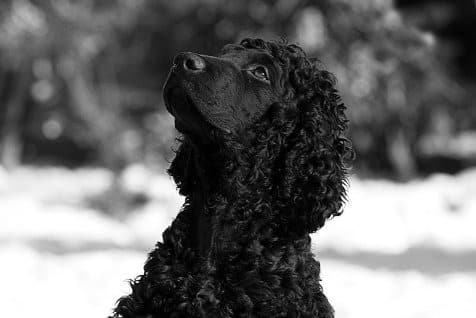
Irish Water Spaniel – History
Explore the IWSCA’s journey in recognizing Irish Water Spaniels’ versatility, highlighting their achievements across multiple AKC titles.

Home » Meet The Breeds » Irish Water Spaniel
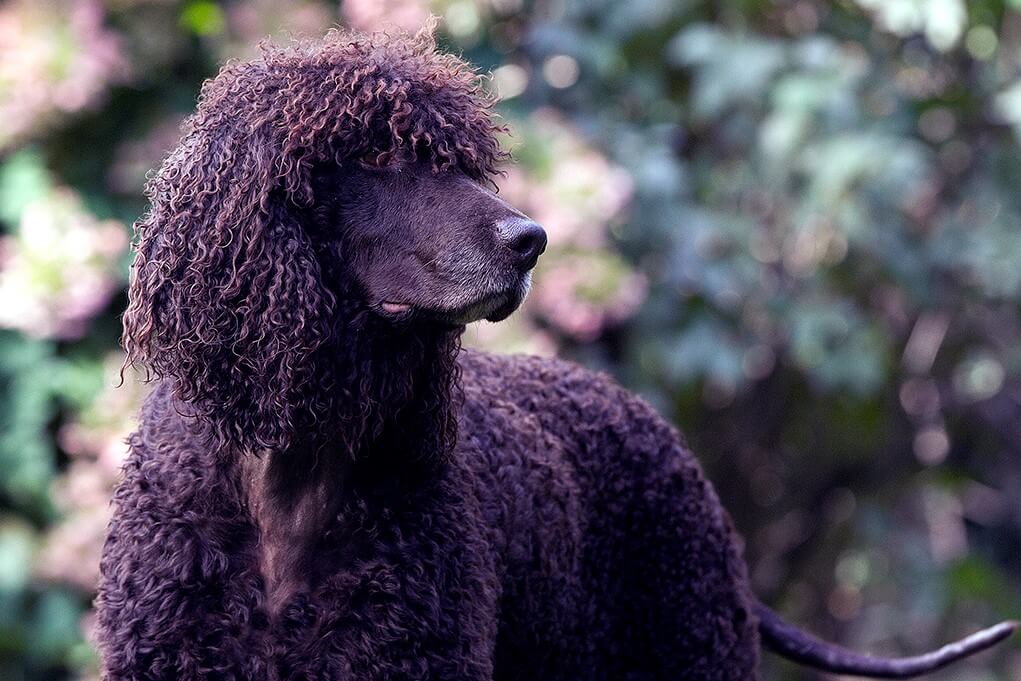

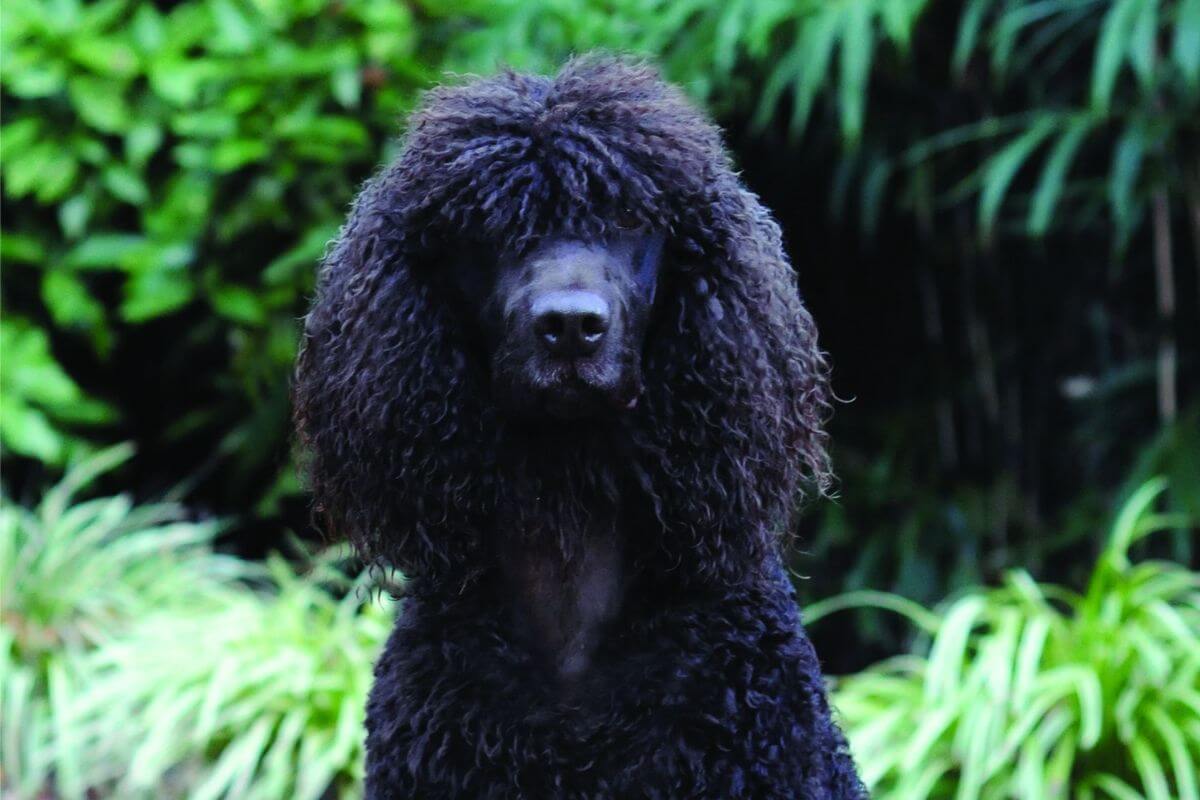
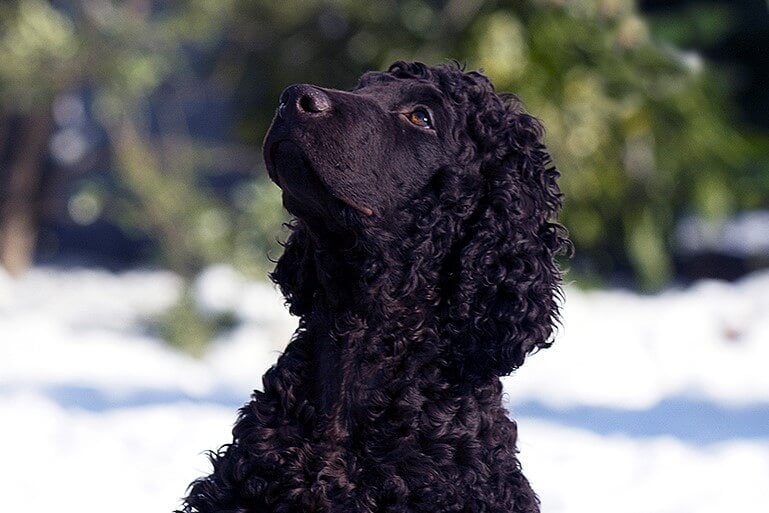
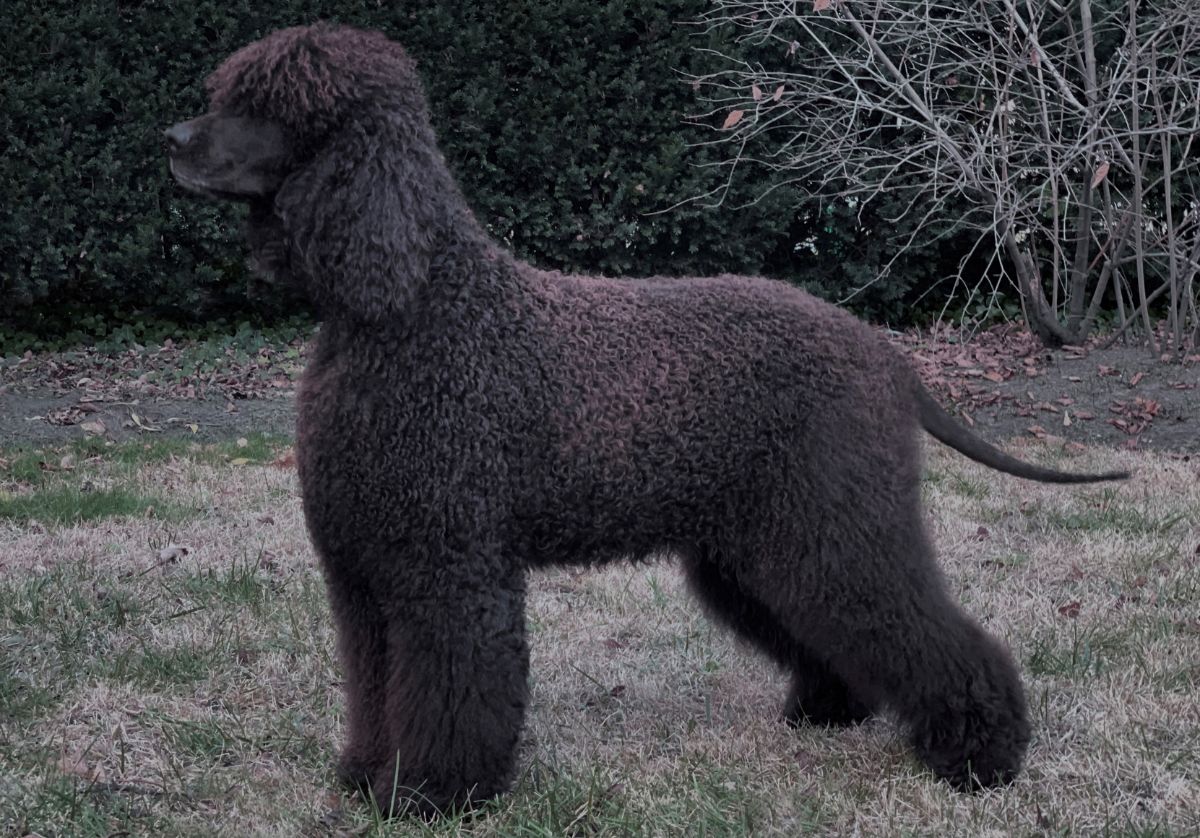
Considered the tallest of the recognized spaniel breeds, the Irish Water Spaniel (IWS) is further distinguished from its cousins by a distinctive topknot, a crisply curled coat with a purplish hue, and a tapering “rat tail.” Originally bred in Ireland as a versatile bird dog, the breed remains adept at flushing gamebirds and retrieving on land and in the water. Known for their loyalty and trainability, these dogs typically make extraordinary companions for active households that are able to accommodate the breed’s high energy and grooming needs. Most IWS today can adapt well to family life, expressing both their intelligence and their sensitivity in everything they do.
Sporting
21 – 24 inches
45 – 68 pounds
12 – 13 years
| Country of Origin | Ireland |
|---|---|
| Bred For | Hunting, Waterfowl Retrieving |
| Known For | Topknot, Curly Coat, Rat Tail, Intelligence, High Energy |
| Popularity | Low |
| Temperament | Smart, Eager, Inquisitive, Sensitive, Active |
| Activities | Hunting, Swimming, Conformation Shows, Dog Sports |
The Irish Water Spaniel (IWS) has a rich history, being one of nine native Irish breeds. Standardized as a unique purebred by the early 19th century, the exact origin of Eire’s waterfowl retriever is a topic of intrigue among canine historians. Some argue the breed descends from indigenous dogs (whose ancestors were perhaps brought to the island by traders from the Middle East), whereas others suggest a more recent development through crosses of local spaniels with various Continental breeds. Precise documentation on the breed’s ancestry has always been scarce; however, the characteristics that distinguish this water spaniel from all other breeds have been well documented for roughly two centuries.
Historically, the Irish Water Spaniel has been prized for its versatility. Initially bred for retrieving game from lakes and rivers as well as in the open ocean and water-soaked bogs, the breed’s skillset was not limited to aquatic environments. The IWS has also excelled as a hunting companion on land, aided by its acute sense of smell and innate retrieving instincts. The breed’s unique coat, although perfectly suited for protecting the dog in cold water, has always been a hindrance in thorny brush and dense cover.
The early recognition of the IWS by major kennel clubs underscores the breed’s distinctiveness within the contemporary canine world. American Kennel Club recognition, in 1878, represents one of the earliest registrations of any breed in the United States, reflecting the breed’s established presence and its popularity among both hunters and dog show enthusiasts.
Despite its early acclaim and adaptability, the Irish Water Spaniel has become a rarity in modern times. Nonetheless, this rather unusual breed is cherished by discerning enthusiasts in North America, Great Britain, Scandinavia, Northern Europe, and of course, in Ireland where it is considered vulnerable to extinction. However, despite the breed’s uncommon status throughout the world, its striking appearance and exuberant personality still garner attention wherever it is found.
An adult male Irish Water Spaniel typically stands at a height of 22 to 24 inches tall at the withers, whereas a mature female is slightly shorter, usually measuring between 21 and 23 inches.
In terms of weight, a male generally weighs between 55 and 68 pounds, while a female typically falls in the range of 45 to 58 pounds.
The Irish Water Spaniel is a harmonious blend of proportion and substance, in moderation. These dogs possess a body that is slightly longer than tall, giving them a robust and off-square appearance in profile. Their general construction exhibits a combination of power and endurance, ensuring they can perform tirelessly whether in the field or in water. The chest is deep with well-sprung ribs, providing ample lung capacity, and the overall musculature is well-developed yet never bulky. This conformation allows for both speed and agility while working. The general appearance of the IWS is one of a well-built, athletic dog that is capable of performing the demanding tasks for which it was originally bred.
Texture: The Irish Water Spaniel is adorned with a distinctive coat that is both functional and visually striking. The oily coat is comprised of dense, tightly curled ringlets that provide superb protection in wet environments. Curls cover the neck, body, and base of the tail, with looser curls or waves on the legs. The texture is neither woolly nor coarse. The skull is crowned with a topknot of long, loose curls that abruptly form a widow’s peak between the eyes, and the ears are cloaked with curls that extend several inches beyond the ear leather. A beard grows where the lower jaw and throat meet. Weekly grooming and periodic scissoring are required to maintain a healthy coat that is free of mats and debris. Curiously, the coat of the IWS is naturally “patterned” with short, smooth hair on the face and muzzle, on the throat in a V-shaped patch, on the front of the rear legs below the hock, and on most of the tail.
| Standard Color | |
|---|---|
| Liver | ee |
A Note About Color: The Irish Water Spaniel’s solid color is a defining characteristic of the breed. The coat is liver-colored with a purplish tinge that’s sometimes called puce liver. This unusual color is particularly noticeable at dawn and dusk. With sun exposure, the coat may take on a bronze hue; however, no white hair or markings are acceptable except for graying due to age.
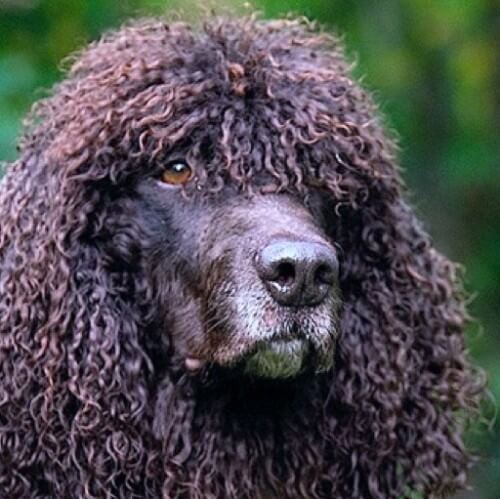
The tail of the Irish Water Spaniel is one of the breed’s most distinctive features, often referred to as a “rat tail.” This unique characteristic sets the breed apart from all other spaniels and water dogs. The tail is low set and thick at the base, relatively straight, and tapers to a fine point. The base of the tail is covered with dense curls similar to those on the body, but the remainder of hair is short, straight, and smooth to the tip. This peculiarity prevents drag in the water, minimizes damage in the field, and gives the tail its altogether unmistakable appearance.
The Irish Water Spaniel’s tail is typically carried level with the back or slightly higher, but it should not be curled or carried over the back. In the show ring, the tail’s unique appearance is a point of focus, as it exemplifies one of the breed’s most celebrated and distinguishing characteristics.
When considering the Irish Water Spaniel as a companion, potential owners should be mindful of the breed’s peculiar characteristics and its care requirements. This breed, known for its intelligence and high energy, thrives in an environment where it can be engaged both physically and mentally. The IWS is well-suited for active families or individuals who enjoy outdoor activities and can provide ample opportunities for exercise and stimulation. Like all spaniels, the IWS is typically sensitive and intuitive. Positive training methods that encourage obedience, without harsh corrections, tend to bring out the best in this breed.
The Irish Water Spaniel is generally a healthy breed with a lifespan that typically ranges between 11 and 13 years. Like all dogs, however, individuals can be prone to certain health risks. With proper diet, regular veterinary check-ups, and an active lifestyle, many issues can be managed or prevented.
Irish Water Spaniels can be predisposed to certain health conditions. Awareness and proactive management of the risks can contribute significantly to the overall health and longevity of this breed. Some of the health issues that IWS owners should be aware of include:
It’s important for Irish Water Spaniel owners to schedule regular veterinary check-ups, as early detection and management of these and other conditions can significantly improve a dog’s quality of life. A balanced diet, regular exercise, and health screenings are also crucial for maintaining good health.
The Irish Water Spaniel is renowned for its bold and playful personality. These dogs are eager learners with a remarkable intelligence, which generally makes them well-suited for active dog owners. The breed’s smartness, however, also means they can be independent thinkers that require thoughtful, positive, and consistent training methods.
Sensitive by nature, Irish Water Spaniels respond best to positive reinforcement and can be quite receptive to their handler’s overall mood. Harsh training techniques are likely to be counterproductive. These dogs are known for being loyal and affectionate with their families, forming strong bonds that may exclude anyone outside the family circle.
Irish Water Spaniels typically prefer to spend time with their own people and are unlikely to thrive when left alone for prolonged periods. Isolation will often lead to boredom and potentially destructive behaviors, so mental and physical stimulation are essential. Participation in activities such as hunting and dog sports are particularly beneficial for this breed.
Typically, the Irish Water Spaniel is somewhat reserved toward strangers and prefers having time to warm up to new people. The breed is not known to be overtly aggressive, but individuals can be assertive if they perceive a threat to their family or property. IWS can get along well with other household pets and often make good playmates for children who are respectful. However, as with any dog, interactions should always be supervised. Early and consistent socialization is essential for this active and intelligent breed.

Feeding and nutrition are critical aspects of caring for an Irish Water Spaniel, a breed known for its high energy and athleticism. For puppies, a diet formulated for large-breed pups will deliver the appropriate nutrients needed without promoting joint problems. Puppies typically require three to four meals daily, but as the IWS transitions into adulthood the frequency of meals can be reduced. The breeder of an IWS can provide guidance on the type and amount of food that is best suited for the breed, with the amount given based on the dog’s age, size, and energy expenditure. Fresh water should always be available, of course, and treats should only be given in moderation as a reward during training sessions. A well-balanced diet, tailored to a dog’s individual requirements, is key to keeping an Irish Water Spaniel healthy and happy.
Training an Irish Water Spaniel can be a rewarding experience, given the breed’s intelligence and eagerness to please. The IWS is well-known for its ability to take direction and solve (or create!) problems, making the breed a good partner for people who establish a consistent and positive training routine. The breed’s intelligence, however, also means these dogs can be independent thinkers. This characteristic calls for a training approach that is both firm and fair. Harsh or negative training methods are likely to be counterproductive and could harm the bond between the dog and its handler. In the right hands, the IWS can perform at advanced levels in a variety of dog sports, including Agility, Dock Diving, and Obedience. Of course, advanced titles in both flushing and retrieving competitions are well within reach for the right dog and handler team. Consistent, positive training and plenty of socialization from an early age are essential to achieve success with this intelligent and intuitive breed.
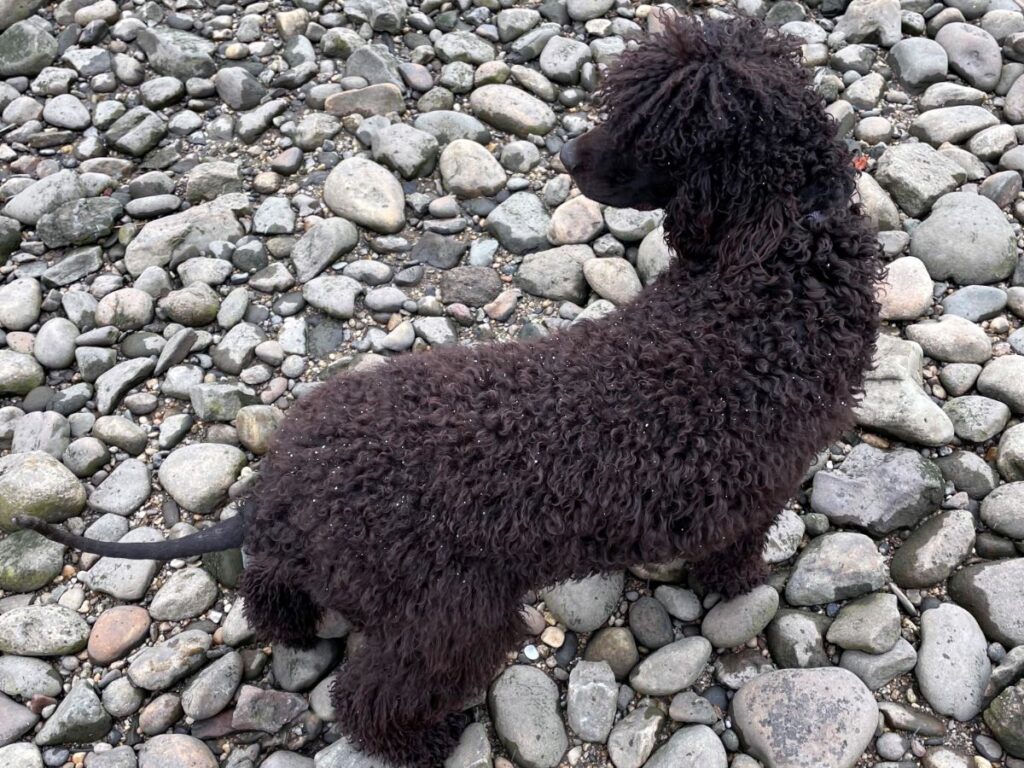
Exercise is a crucial part of the Irish Water Spaniel’s daily routine. This breed absolutely thrives on physical activity and mental challenges. Establishing a daily routine that includes short training sessions and periods of free-range fun will help to keep the IWS stimulated and satisfied at the end of the day.
| Energy Level | High |
|---|---|
| Exercise Requirements | 2 Hours/Day (Minimum), Daily Walks, Weekly Swimming, Vigorous Running, Playing with Another Dog, Mental Stimulation |
The exercise needs of an Irish Water Spaniel are relatively high. This is an energetic breed that requires a variety of activities, including swimming, running, and playing fetch, that not only cater to the dog’s physical needs but also provide the mental stimulation that is essential for this intelligent breed. The intensity of exercise should match the individual dog’s age and energy level; however, it’s important to balance vigorous activities with periods of rest to prevent overexertion. As puppies, exercise should be moderate to protect developing bones and joints, and it’s best to avoid strenuous activities, such as running alongside a bike, until the dog is two years old. It’s also important to note that an IWS that doesn’t receive adequate exercise can exhibit behavioral issues created by boredom and a lot of pent-up energy. Therefore, regular, structured exercise is key to a happy partnership. For active people who want to integrate a dog into their outdoor lifestyle, the Irish Water Spaniel can be a great choice as a companion.
Grooming is an essential aspect of caring for an Irish Water Spaniel, a breed known for its distinctive, curly coat. A weekly grooming routine will not only keep the dog’s coat looking its best, it also provides an opportunity to check the health of the ears, nails, and teeth.
| Coat Type | Dense, Tight, Curly |
|---|---|
| Grooming Requirements | Weekly Brushing, Occasional Bathing, Routine Ear Cleaning, Periodic Nail Trimming, Regular Tooth Brushing |
The coat of the Irish Water Spaniel consists of tight, crisp, water-repellent ringlets on the neck, body, and base of the tail. Longer, looser curls cover the topknot, ears, beard, and legs, while short, smooth hair covers the muzzle, throat, fronts of the rear legs from the hock to the foot, and the majority of the tail. The breed’s unique coat requires regular maintenance to distribute the skin’s natural oils, remove any debris, and prevent mats from forming. Brushing the coat weekly is recommended, and periodic trimming is essential for both the dog’s comfort and for neatness sake. Shedding is generally moderate in the breed, although the dead hair does largely become entangled in the curls. This characteristic mandates a commitment to brushing and makes the IWS a potential option for individuals with mild allergies. Bathing this breed should only be done as needed, and it’s important to use a dog-specific shampoo that will not strip too much of the skin’s natural oils. Grooming, of course, also includes nail trimming, ear cleaning, and dental care. In particular, the ears require weekly attention due to their size and shape, which predisposes them to ear infections. Professional grooming every few months can also be beneficial, especially for maintaining the Irish Water Spaniel’s breed-typical curls.

Living with an Irish Water Spaniel can be a rewarding experience, but it requires accommodating the specific needs of this high energy and extremely intelligent breed. These energetic dogs thrive when they have ample space to explore and opportunities for vigorous physical activity. With plenty of room to run (and the chance to swim), the IWS will prove itself to be an eager and determined outdoor companion. Ownership requires a commitment to daily exercise routines that include long walks and free-runs. Mental stimulation, through interactive toys and training exercises, is also crucial for keeping these dogs engaged. In terms of adaptability to various climates, the IWS is generally tolerant of cold weather; however, snow can accumulate on the bottoms of the feet, which makes walking difficult. During warm summer months it’s crucial to provide plenty of water for both drinking and bathing. Like any useful gun dog, the Irish Water Spaniel is exceedingly affectionate and devoted to its family, and can even be content living with a single person. Nonetheless, the breed’s innate instincts require early and frequent socialization to prevent an individual dog from becoming overly protective and suspicious of strangers, including small children, neighborhood dogs, and the mail carrier.
The arrival of a litter of Irish Water Spaniel puppies is a cause for celebration. The pups of this Sporting breed are well-known for their playful and curious nature, and for many months (or years) they can be counted on to bring plenty of energy wherever they go and to everything they do.
From the moment an Irish Water Spaniel puppy captures your heart, a journey of growth and discovery begins for both dog and owner. Initially, creating a safe and welcoming environment is crucial. Puppies of this breed are naturally curious and will explore their surroundings, so it’s important to puppy-proof the home and remove any hazards. Good nutrition also plays a vital role in the puppy’s growth and development, so feeding a high-quality puppy food several times a day is recommended. For these active and intelligent pups, socialization and training should start early. Safely exposing the young IWS to a variety of people, environments, and situations helps with developing a confident adult dog. Positive reinforcement techniques work best for training, as they encourage learning and strengthen the bond between the puppy and its people. Exercise should always be appropriate for the puppy’s age. Too much exercise can be harmful to developing bones and joints, so short walks, play sessions, and swimming are the safest ways to expend all that energy. And since puppies of this breed eventually grow a long, curly coat, grooming habits should be established early. Regular brushing will help the pup become accustomed to being handled and groomed. As for healthcare, following the guidelines suggested by your puppy’s breeder, and providing regular veterinary check-ups, is essential.
Irish Water Spaniels, with their high energy and intelligence, typically excel in many dog sports and outdoor activities. Participation is not only beneficial for meeting a dog’s exercise requirements, it also provides mental stimulation and strengthens the bond between an IWS and its handler.
Performance events are particularly well-suited for this breed, given its athleticism and eagerness to learn new things. Some of the sports in which Irish Water Spaniels commonly participate include:
These activities and others not only provide physical and mental stimulation for the Irish Water Spaniel, they also offer opportunities for socialization and community involvement. Engaging an IWS in these endeavors can lead to experiences that challenge both the dog and the handler as their team becomes connected to a community of like-minded dog sports enthusiasts.
The Irish Water Spaniel is recognized by the world’s leading registries and kennel organizations, which categorize the breed into a specific Group based on its unique characteristics. This breed is recognized worldwide under the following Group designations:
| Organization | Group Designation |
|---|---|
| AKC (American Kennel Club) | Sporting |
| UKC (United Kennel Club) | Gun Dog |
| CKC (Canadian Kennel Club) | Sporting Dogs |
| ANKC (Australian National Kennel Council) | Gundogs |
| RKC (The Royal Kennel Club) | Gundog |
| FCI (Fédération Cynologique Internationale) | Group 8: Retrievers, Flushing Dogs, Water Dogs; Section 3: Water Dogs |
The ideal Irish Water Spaniel is described by a Breed Standard that is approved by each of the world’s leading registries and kennel organizations. The Breed Standards for this breed may be found in the following links:
| Organization | Breed Standard |
|---|---|
| American Kennel Club | AKC Irish Water Spaniel Breed Standard |
| United Kennel Club | UKC Irish Water Spaniel Breed Standard |
| Canadian Kennel Club | CKC Irish Water Spaniel Breed Standard |
| Australian National Kennel Council | ANKC Irish Water Spaniel Breed Standard |
| The Royal Kennel Club | RKC Irish Water Spaniel Breed Standard |
| Fédération Cynologique Internationale | FCI Irish Water Spaniel Breed Standard |
Getting involved in an Irish Water Spaniel club can be a rewarding experience for both dog and owner. These organizations offer support, resources, and a community of like-minded individuals who share a passion for this energetic and intelligent breed.
In the US, The Irish Water Spaniel Club of America (IWSCA) is the primary organization dedicated to the breed. The IWSCA focuses on the promotion, protection, and preservation of these unique purebreds, providing a platform for breed education, training, and healthcare.
In Canada, the Irish Water Spaniel is represented by The Irish Water Spaniel Association of Canada. This organization similarly works to promote the breed, offering resources and support for breeders, owners, and enthusiasts across the provinces.
In the United Kingdom, the Irish Water Spaniel Association is the key organization dedicated to the breed. It functions similarly to its American and Canadian counterparts, offering resources and support for anyone who becomes captivated by the breed’s many charms.
Membership in these clubs is open to anyone with an interest in the Irish Water Spaniel, whether a current owner, prospective supporter, or simply an ardent admirer. Being part of these organizations can be immensely rewarding, offering educational resources, opportunities for involvement in breed-specific activities, and a sense of community among those who share a love for this remarkable breed.
Rescue groups can play a crucial role in an Irish Water Spaniel’s lifetime of care, offering a second chance to any dog in need. Volunteer club members are ready to mobilize at a moment’s notice to rescue, rehabilitate, and rehome any vulnerable IWS.
In the US, members of The Irish Water Spaniel Club of America (IWSCA) are committed to providing support and resources. This club can quickly respond to receiving news of any lost, abandoned, or surrendered IWS. The IWSCA not only facilitates placement services, it also invests in education and resources to support anyone who needs to place their dog in a new home.
The Irish Water Spaniel Association of Canada and the Irish Water Spaniel Association in the UK play significant roles in supporting IWS in need within their respective communities. Members of these clubs work tirelessly to support any dog that finds itself in trouble, providing the necessary care and placement services that are needed.
Irish Water Spaniels are often considered to be a good dog for people with allergies, though it’s important to note that no dog is completely hypoallergenic. These dogs have a dense, curly coat that tends to trap dander rather than shed it. Due to this type of coat, the IWS typically produces less dander than many other breeds, which can be beneficial for people with mild allergies to dogs.
Irish Water Spaniels are known for their low-shedding coats, making them a popular choice for those seeking a breed that won’t leave much hair around the house. Their tight, curly hair minimizes the amount of coat that’s shed. However, regular grooming is essential to prevent mats and to keep the coat in good condition.
Irish Water Spaniels are generally not known for being aggressive. They are typically friendly and outgoing, but, like any dog, their temperament can be influenced by a variety of factors, including genetics, training, and socialization. It’s important for owners to provide the IWS with early and consistent exposure to various experiences, and positive training to promote good behavior.
Irish Water Spaniels can make excellent pets in the right household. These dogs are intelligent, energetic, and affectionate, and they enjoy being part of the family. They thrive with regular exercise and mental stimulation, which makes them an ideal match for active individuals. Their trainability also makes them well-suited for families with older children, as long as the necessary engagement and care are overseen by a responsible adult.
While Irish Water Spaniels are hardy and adaptable, they thrive best when they are part of the family and live indoors. This is a very social breed that forms strong bonds with its owners and can become lonely or stressed if left outdoors for extended periods. A comfortable home, regular interaction, and mental stimulation are essential for the well-being of an IWS.
Irish Water Spaniels are a medium-to-large breed. Males typically stand between 22 and 24 inches tall at the shoulder and weigh between 55 and 68 pounds, while females are generally shorter and smaller. The breed’s size, combined with its curly coat, athletic build, and eager disposition, gives the IWS a distinctive and robust appearance.
An Irish Water Spaniel typically lives for 12 to 13 years. Like all dogs, however, longevity can be affected by several factors such as genetics, diet, exercise, environment, and the quality of veterinary care. Regular check-ups, a balanced diet, and an active lifestyle can contribute to a longer, healthier life for these dogs.

Explore the IWSCA’s journey in recognizing Irish Water Spaniels’ versatility, highlighting their achievements across multiple AKC titles.
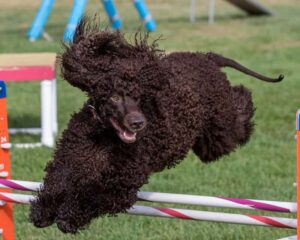
It’s fantastic to have a dog that has high-level titles on both ends. Learn how this can be done even with limited time and resources.

IWSCA National Specialty 2021 gathered Rat Tail Spaniel enthusiasts at Post Oak Lodge in Oklahoma for a week of events and camaraderie.

Hannah L. Loonsk shares her journey as an Irish Water Spaniel breeder, owner-handler, and veterinarian passionate about the breed.

Stacy Duncan is the breeder behind Flintcrest Irish Water Spaniels. Read about the kennel’s beginnings, the sires, the dams, and more!

Mark Barker, DVM, and Sondra Barker are the breeders behind Sycomore Irish Water Spaniels. Read about the kennel’s beginnings and more!
Dan Sayers: Where do I live? How many years in dogs? How many years as a breeder? I live in Merchantville, New Jersey, near Philadelphia.
The best way to ensure a long and happy relationship with a purebred dog is to purchase one from a responsible breeder. Not sure where to begin?
Contact the National Parent Club’s Breeder Referral Program, which is listed on the AKC Breeder Referral Contacts page.
